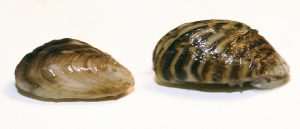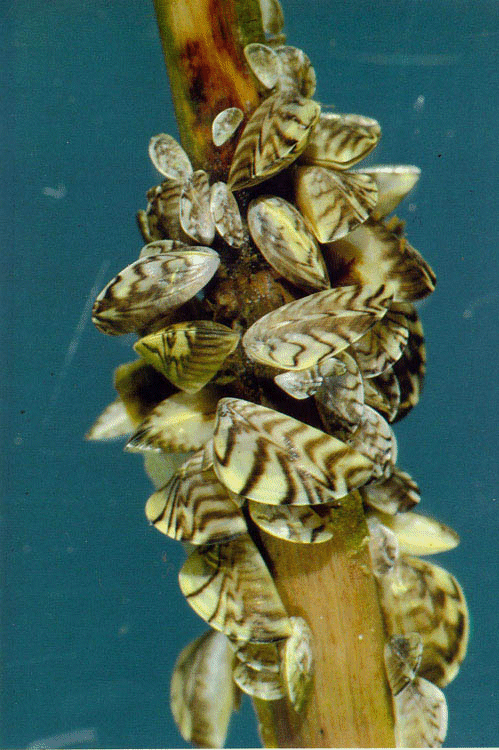

Zebra mussels (Dreissena polymorpha) are among the most devastating aquatic invasive species to invade North American fresh waters. Native to the Caspian Sea region of Asia, zebra mussels reached the Great Lakes in the mid-1980s in the ballast water of a ship. Since their arrival, zebra mussels have spread rapidly throughout the Great Lakes and into several major river systems of the eastern United States, including the Ohio. Illinois, Mississippi, Mohawk, Hudson, Susquehanna, Tennessee and Arkansas rivers. Populations are now known from at least 23 states, primarily within the Great Lakes and Mississippi River watersheds.
This species continues to spread and threaten many lakes and rivers across the United States.
See a progression of the invasion of the mollusk in the United States.
Zebra mussels look like small clams, ranging from 1/8 to 2 inches in length. The shell is “D” shaped and white or cream-colored with jagged brown or black stripes. Zebra mussels may be confused with their invasive cousin, the quagga mussel (Dreissena bugensis). The shell of the quagga mussels is rounder and usually light tan to almost white, with black, cream, or white bands. Both species have byssal threads (or ropes) on the hinge edge of their shells that allow them to attach to solid objects. These threads are unique to zebra and quagga mussels and are not found on native mussels.
Female zebra mussels can produce up to one million eggs per summer.
Fertilized eggs develop into free-swimming larvae called veligers. These veligers are not visible to the naked eye and are about the width of a human hair. Within 2-3 weeks, the veligers begin to ‘settle-out’ in the water under the weight of their forming shells and attach to firm, underwater surfaces. Once attached it takes approximately one year for the mussel to grow one inch and become sexually mature. On average, zebra mussels live 2-5 years.
Densities of zebra mussels can reach over 100,000 individuals per square meter.
Zebra mussels usually grow in clusters and are generally found in shallow (6-30 feet), algae-rich water. Their ability to attach to hard surfaces results from the tuft of fibers located at the hinge of their shell called byssal threads. These threads produce powerful glue that anchors the mussel in place. Any hard surface is a suitable place for a mussel to live and may include rock, metal, wood, vinyl, glass, rubber, fiberglass, or paper. Zebra mussels may even colonize living organisms such as plants, other mussels, and the bodies of slow moving animals like turtles.
Zebra mussels have had deleterious effects on waterbodies where they become established. Adult zebra mussels feed by filtering large amounts of plankton and detritus from the water. While some aspects of filtering the water are positive, the words “filter” and “clean” are not synonymous. Zebra mussels eat phytoplankton, small zooplankton, large bacteria, and organic detritus by filtering the water and straining out the edible material. Phytoplankton and zooplankton form the base of the aquatic food web and many animals depend on them for survival. By removing this food from the water column, zebra mussels effectively starve the native populations of infested lakes and rivers.
Each zebra mussel can filter one liter of water per day.
In addition, zebra mussels accumulate contaminants within their tissues, increasing the exposure of these toxins to wildlife that consume mussels. Zebra mussel infestations also threaten native mussel populations by attaching to the shells of these species and smothering them. Many native mussel populations that share waters with zebra mussels have decreased to the point of being threatened or endangered.
Zebra mussels cost taxpayers hundreds of millions of dollars a year.
Zebra mussels clog water intake pipes and filters, reducing water pumping capabilities for power and water treatment plants. They can also damage boats by encrusting boat hulls; clogging water systems used in boat motors, air conditioners and heads; and causing navigation buoys to sink. Beaches may become unusable as a result of the sharp shells and pungent odor that are characteristic of bivalve invasions.
Both adult zebra mussels and the larval form, known as veligers, can be transported into other bodies of water. Adult zebra mussels can attach to boats or other equipment and be transported to new waters.
Adult zebra mussels are able to close their shell and may survive out of water for several days.
Veligers are able to hitchhike in water held in the bilge, live wells, motors, or bait buckets, or they may cling to plant fragments, boats or trailers, or other equipment or recreational items that came into contact with water.
You can’t always see zebra mussels because their larvae are invisible to the naked eye. They can survive for days in water trapped in a boat. The only way to be sure you’re not carrying zebra mussels to another body of water is to always Clean Drain Dry your boat, trailer, and gear. To minimize the potential spread of zebra mussels, follow these simple steps: